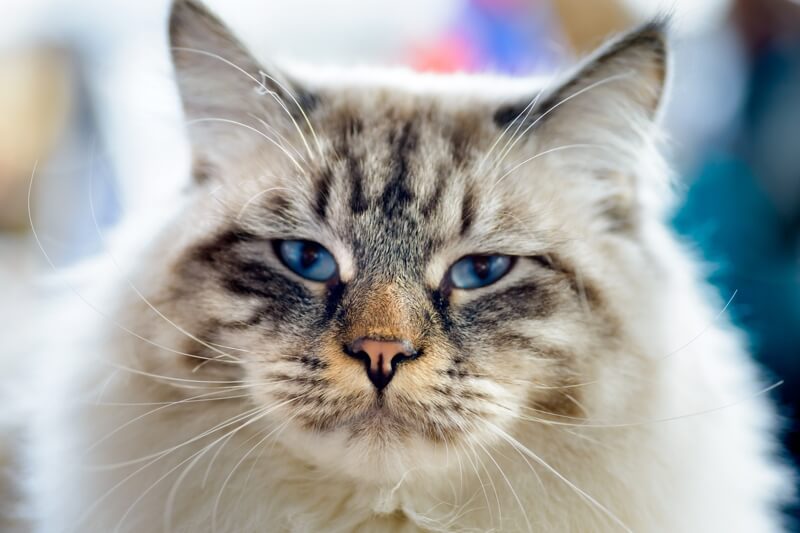What is a Tiffanie cat? These long-haired felines are loving, social, and mellow. They prefer to spend their time curled up in your lap and adore hanging out with their family. Are you considering adopting a Tiffanie? Then read on to learn more about this breed.
Breed History
The Tiffanie cat breed originated in England during the 1980s after a Burmese and a Persian Chinchilla cat had kittens together. These new kittens were both short and long-haired—the short-haired becoming known as the Burmilla. Further breeding with the long-haired cats and Burmillas resulted in the Tiffanie breed.
Making their first appearance only a few decades ago, the Tiffanie cat breed is a relatively new/young breed. These cats are also quite rare, particularly in the United States.
Before adopting a cat, it’s essential to understand the financial commitment that comes along with being a pet parent. Do you know how much it costs to have a cat?
Attributes
Tiffanie cats are a medium-sized breed that typically weighs between 8-15 pounds. They have a semi-long to long, silky coat that can come in solid colors of blue, black, chocolate, silver, lilac, champagne, platinum, and fawn. Tiffanies have bright, golden eyes. An expected lifespan for cats of this breed is 7-12 years, though many factors can affect your cat’s life expectancy.
The Tiffanie cat temperament is perfect for all types of families. These cats can do well in a large, busy home or a household of one person. What’s more important to a Tiffanie cat is that they just aren’t left alone for extended periods every day. These felines can experience separation anxiety and become lonely and bored if they don’t have any company.
As a Tiffanie parent, it may be worth considering the option of having another cat or cat-friendly dog in your home—someone who will be a good companion for your Tiffanie while you aren’t home. Luckily, Tiffanie cats typically get along wonderfully with other pets. Just be sure to take your time when introducing pets to one another.
Many cat parents wonder, “Are Tiffanie cats friendly?” Simply put, they most definitely are. Tiffanie cats have a mellow personality, and they are happiest when in the company of others. They don’t mind new people coming to your house since they typically view them as potential new friends or someone else to give them attention. Tiffanies even get along well with children, as long as the kids know how to interact with cats correctly.
Another question pet parents have about this breed includes, “Are Tiffanie cats hypoallergenic?” This breed is not hypoallergenic, meaning that if you have a cat allergy, this probably isn’t the best choice for you.

Grooming and Care
An essential part of caring for your Tiffanie cat is to keep them well-groomed—this includes more than just coat care. Of course, because these cats have long hair, they will need to be brushed multiple times a week. This can help keep their coat healthy, and it can collect any loose hairs.
Other items on your cat’s grooming list should include checking their ears, brushing their teeth, and trimming their nails. Check your cat’s ears on a regular basis, cleaning them out with a cotton ball and cat ear-safe cleaning solution whenever they appear dirty. Never use cotton swabs as this could accidentally cause injury. If you ever notice a poor odor or unusual redness, schedule an appointment with your veterinarian, as this could be the sign of an ear infection.
Brushing your pet’s teeth should also be part of your weekly schedule. Using a pet-friendly toothbrush (human toothbrushes typically have too tough of bristles) and cat-safe toothpaste, cleaning your pal’s pearly whites a few times a week can help reduce their chances of developing periodontal disease.
Every few weeks, you will need to trim your cat’s nails. All you need is a pair of cat nail trimmers, but make sure you know how short to cut their nails. If you are not yet comfortable with doing this grooming item, you can talk with your veterinarian or a local pet groomer, both of which may be able to offer you helpful advice or even trim your cat’s nails for you.
Besides keeping your cat well-groomed, another part of caring for a Tiffanie includes providing them with a nutritious diet. It’s crucial that your feline friend is receiving the correct type of food, along with getting the appropriate amount of food per meal and per day. Overfeeding can lead to unwanted weight gain.
Thankfully, Tiffanie cats are playful, so encouraging physical exercise is an excellent way to keep them at a healthy weight. Exercise is additionally vital to your cat’s happiness and well-being because it can help them avoid boredom. Tiffanies are intelligent cats, so you may want to consider purchasing some puzzle games or interactive toys.
It's essential that you provide your cat with clean drinking water. Learn the dangers of dirty water and how to keep your pet’s water clean.
Common Health Issues
Tiffanies are considered to be inherently healthy, but like any other cat breed, they can still be susceptible to developing some health issues. According to our claims data,** some common health problems include respiratory and gastrointestinal issues.
To help keep your cat in the best health, annual veterinary appointments are a must. Even if your pal appears to be perfectly healthy, it’s still crucial that you take them for an examination. Though one check-up a year is typically suggested, if you notice any significant changes to your cat’s health, behavior, or appearance, it’s highly encouraged that you schedule another visit right away.
Your veterinarian can also be a fantastic resource. Veterinarian visits are an ideal time for you to bring up any questions or concerns you may have about your cat. These can also include more general questions about raising a cat.
Fun Facts
Since many people may not be as familiar with the Tiffanie breed as they are with other common cat breeds, some fun facts can be helpful to learn more about these beautiful cats.
- Tiffanies are also known as the Chantilly or the Longhaired Burmilla.
- This breed is relatively rare in the United States, so it’s not always easy finding one.
- Although not outwardly vocal like the Siamese breed, Tiffanies will hold a conversation with you or make a chirping sound when they want your attention.
- Along with their other names, this breed is also referred to as the Asian Semi-Longhair.
No matter which name you refer to this breed by, one thing is for sure—these cats are unique in more ways than one.
Names
After adopting your Tiffanie, the next step is to pick a name. Although this may be an easy task for some people, this can be a daunting task for the more indecisive pet parent. In order to help narrow down the choices, here’s a list of autumn and winter-inspired cat names to choose from,
- Leif
- Casper
- Hazel
- Fang
- Onyx
- Hocus
- Nutmeg
- Wren
- Yeti
- Evie
Are you ready to begin spoiling your new best friend? Here are some cat-tastic treat recipes you can easily make.
**Internal Claims Data, 2015-20
The information presented in this article is for educational and informational purposes only and does not constitute or substitute for the advice of your veterinarian.







